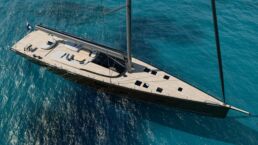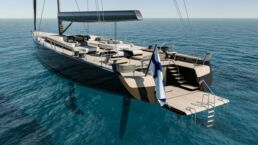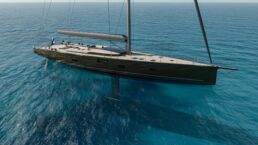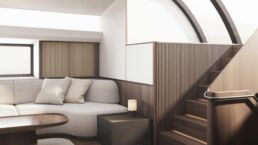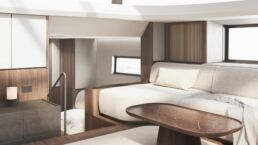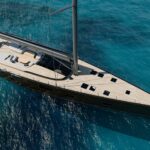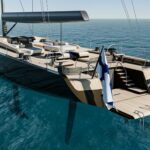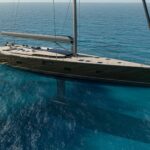ZEMI is a 33.50m sailing yacht by Finnish yacht builder Baltic Yachts with exterior lines by Malcolm McKeon and interior design by Andreas Martin-Löf Arkitekter.
The owner of Zemi has decided to utilize a zero-emissions electric propulsion system, which involves a 247kW Danfoss motor directly connected to a four-bladed folding propeller. This choice deviates from the more common controllable pitch propeller. By eliminating the need for a gearbox and hydraulic controls associated with a controllable pitch propeller, the drive train of the vessel has been simplified, resulting in fewer components, reduced space requirements, and significant weight savings.
To power the electric propulsion system and meet all domestic, hydraulic, and rig handling needs, two 129kW gensets are employed to charge a large bank of lithium-ion batteries. Additionally, the folding propeller can be used for hydrogeneration, generating electricity while the vessel is sailing.
Zemi was meticulously built to Baltic’s rigorous standards using advanced carbon composites under the design expertise of Malcolm McKeon. Primarily intended as a luxurious performance cruising yacht, it can accommodate the owner’s family and friends for global sailing in high and low latitudes. The name “Zemi” pays homage to an ancient Caribbean deity.
Zemi’s telescopic lifting keel, which boasts a 28-tonne bulb, reduces draft from 6m to 3.95m to access various anchorages on her global voyage. Additionally, her twin rudders add to her maneuverability.
After undergoing trials off Jakobstad this summer, Zemi will begin her journey by heading north towards Norway, then continuing to Svalbard and Iceland before turning south towards Scotland. From there, she will go to the Canaries and cross the Atlantic to participate in the prestigious St Barths Bucket Regatta in 2024.
Interior of ZEMI
The interior of Zemi has been skillfully designed by the esteemed Swedish architect Andreas Martin-Löf, known for his minimalist style and commitment to sustainability. His attention to detail and focus on craftsmanship have created a cozy and inviting atmosphere in the accommodation. Walnut timber, mainly in veneer form, has been expertly bonded onto lightweight honeycomb structures to save weight. This weight-saving concept is also applied to the head compartments, where light carcasses are adorned with limestone veneers for sinks and surfaces.
The designer’s meticulous approach to lighting is evident throughout the yacht. Lanterns made from Japanese rice paper and walnut strips have been strategically placed in the corners of the saloon, while discreetly mounted light sources in panel divides to create a subtle and peaceful ambiance. Furthermore, the interior is filled with abundant natural light through the 1.8m long saloon hull ports and extensive coachroof skylights.
SHARING IS CARING - THANK YOU!
About Publisher
 Ahoy, I’m René, the “captain” of this luxury yacht blog, and found my passion for the big ones at the age of 17. I have grown up with sailing since a little child. I have an education in Business Informatics and specialized in digital media solutions (alongside luxury yachts) like Online-Marketing, User Experience Design et cetera. My home port is in Oldenburg, Germany next to Lürssen and Abeking & Rasmussen. More about yachtemoceans
Ahoy, I’m René, the “captain” of this luxury yacht blog, and found my passion for the big ones at the age of 17. I have grown up with sailing since a little child. I have an education in Business Informatics and specialized in digital media solutions (alongside luxury yachts) like Online-Marketing, User Experience Design et cetera. My home port is in Oldenburg, Germany next to Lürssen and Abeking & Rasmussen. More about yachtemoceans
